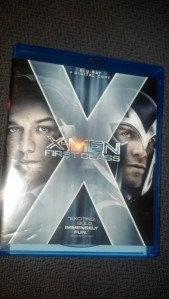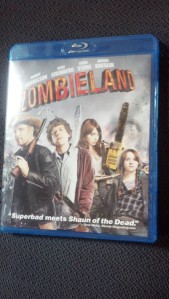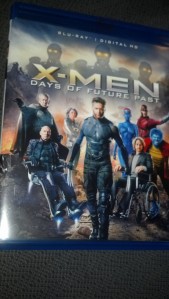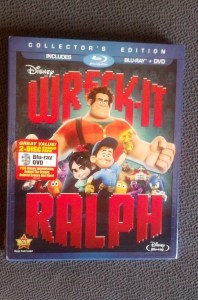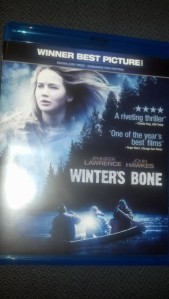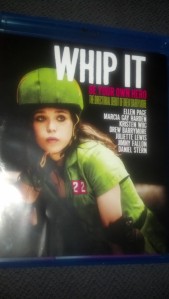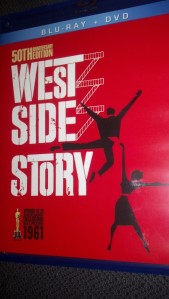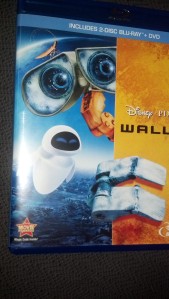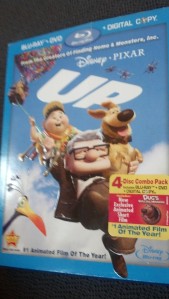
The Task: Watch and write about every movie on my shelf, in order (Blu-rays are sorted after DVDs), by June 10, 2015. Remaining movies: 2 Days to go: 4
Movie #438: X-Men: First Class
From what I understand, comics get rebooted all the time, with a new set of stories that can have little connection to whatever came before. Movies about comic book characters do this too, with every new director’s vision of Superman, for example, or Batman or Spider-Man. These franchises often, in fact, tell the same stories over and over again, such as the hero’s origin story. What makes X-Men: First Class interesting, therefore, is its attempt to reboot the series while also a) telling a whole new set of stories about these characters, from a completely different time in their lives, and b) keeping a connection to the earlier series.
In X-Men: First Class, we meet Charles Xavier (James McAvoy) and Eric Lensherr (Michael Fassbender) as children (played by Laurence Belcher and Bill Milner, respectively) and then as young men. Likewise, we meet Raven (Jennifer Lawrence) as a little girl (played by Morgan Lily) who grows up with Charles in his home after he catches her alone and hungry and looking for food. These people who were linchpins to the original series of films — power players with clearly alluded to long and significantly linked backstories — are getting, in essence, their origin story. We’re introduced to their very different histories, and we’re shown how they grew together and apart in the span of a very critical time in world history.
There are things I really like about the film, and things I don’t like so much, putting it actually on par with perhaps The Last Stand with regard to my preferences. The mutant villains, for example (because the film is truly about mutants versus mutants, in the long run — humans are sort of incompetent bystanders to the whole thing), are lacking in the kind of charisma that makes Magneto himself so compelling in later films (and in this one, too, as Eric shares a lot of their beliefs and even converts Raven to embracing her Mystique self), making it incredibly lopsided. Sebastian Shaw (Kevin Bacon) is despicable, and he doesn’t make a good leader. He tells Emma Frost (January Jones) that they don’t hurt their own kind, but he spends a lot of time doing just that — especially when he kills Darwin (Edi Gathegi) for no good reason. Beyond that, his superpower just makes him look gross, like when his head and hands get inordinately big as he absorbs energy. It’s not attractive. Emma Frost herself is also disappointingly bland, and she’s the only one of Shaw’s minions who does anything interesting. The rest don’t even have lines, I don’t think. And Angel (Zoe Kravitz) doesn’t even bat an eye when Darwin is killed, so forget her.
What it gets right, though, is awesome. The performances of McAvoy and Fassbender (and Lawrence, and Nicholas Hoult as Beast) are phenomenal and moving. Fassbender and Lawrence, especially, bring every ounce of emotion necessary to their character arcs — all the pain, all the anger, all the frustration and isolation they’ve felt over the years. It’s essential to developing who they are and who they become, and both actors are incredible. Beast has a similar, if not as deeply developed, history of feeling like a freak, and Hoult delivers on that. Xavier’s past is not as fraught with hardship, as his life has been filled with financial privilege and his mutation is a strategic advantage in most situations, explaining his much more positive outlook on humanity and reinforcing his desire to work with it instead of against it. I’m also a big fan of Rose Byrne as Moira, not only because she’s an undervalued member of the CIA — being a woman — but because she’s not afraid to use her undergarments to get her into a club for some good old American spying.
The time period also lends itself well to the tale of potential mutant uprisings, I think, as the Cuban Missile Crisis was indeed a very tense moment in our collective history, and one that is taught to have been resolved as if by a stroke of luck, at the last moment, almost out of nowhere. There’s an air of mystery to it that, to be perfectly frank, a secret mutant storyline fits squarely into. It’s kind of brilliant.
I also LOVE LOVE LOVE LOVE LOVE the cameos by Hugh Jackman (as Wolverine) and Rebecca Romijn (as older Mystique), because they are awesome. Like, I literally clapped my hands with glee the first time I saw them. And I maybe still do for Wolverine.
Obviously loving and hating so many different things about it means X-Men: First Class isn’t my favorite of the X-Men films (that would still be X2), but I applaud its ability to create a whole new franchise inside an existing one, and I really do love where this new line can take us. As the next one will attest, most anything is possible.
